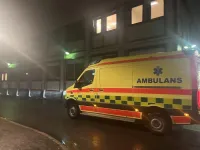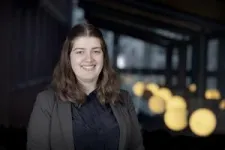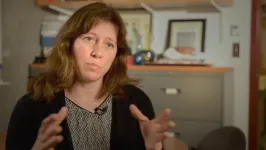(Press-News.org) Assessing how seriously injured a person is, involves weighing up lots of different parameters fast. If healthcare professionals could get support making fast-paced, life-critical decisions from an AI tool, more lives could be saved. This is shown by research from Chalmers University of Technology in Sweden, along with the University of Gothenburg and the University of Borås.
"If severely injured people are transported directly to a university hospital, the chances of survival increase, as there are resources to take care of all types of injuries. Therefore, we need to be able to better say who is severely injured, and who is not, so that everyone receives the right care and that resources are used in the best way," says Anna Bakidou, doctoral student in the research group Care@Distance – Remote and Prehospital Digital Health at the Department of Electrical Engineering at Chalmers University of Technology.
In a recently published study, Anna Bakidou and her co-authors have developed five different mathematical models based on the data of adults who came into contact with ambulance care between 2013 and 2020. This data is from over 47,000 real events, retrieved from the Swedish Trauma Registry, which also showed where the people had been transported. By weighing up a number of complex variables, such as respiratory rate, injury type, blood pressure, age and gender, it turned out that all AI models could perform better than the clinical outcome – which were the transport decisions made by the ambulance staff at the time of the incident.
Many severely injured taken to regular hospitals
It turned out that 40 percent of the severely injured patients were not sent directly to a university hospital. At the same time, 45 percent of the non-severely injured were sent to university hospitals unnecessarily, as their injuries could have been taken care of in a regular hospital.
"Ambulance personnel are constantly faced with difficult and quick decisions. Our hope is that a more objective decision support system will be able to function as an 'extra colleague' that makes staff see more complex connections and think twice in cases where injuries can be difficult to perceive or assess," says Anna Bakidou.
As an example, she mentions that younger people – who are often involved in traffic accidents – are frequently judged to be more severely injured than they are. On the other hand; older people, who are involved in events such as fall accidents, are often assessed as mildly injured – despite the fact that their condition can suddenly become life-threatening, due to consequences such as internal bleeding.
Several steps before the technology can be put into use
Although the mathematical models show that many human lives could potentially be saved, there is still a long way to go before ambulance staff can use the technology. A crucial step is to find methods to input all of the information quickly and easily into the AI tool, and for the service to be able to interact with the users in a good way.
"For example, can you talk to the tool to be able to have both hands free? How can existing routines and protocols be used to work together with the AI, and how can the advice to staff be updated when new data is added? We need to test and take these things into account when we proceed with more studies and prototype work," says Anna Bakidou.
Before AI services could become part of everyday life for ambulance staff, large-scale clinical trials over time are also required.
"The regulations mean that it takes time and there is also a fear of AI. There can be serious consequences if things go wrong. Everything that is to be introduced into healthcare must be validated. At the same time, we know that some of the methods used today are not always the best. When it comes to ambulance care, there is not much research on AI, and we hope that our mathematical models will be able to contribute with support that is adapted to the work environment and that in the long run provides more equal care," says co-author Stefan Candefjord, Associate Professor at the Department of Electrical Engineering at Chalmers.
More about the research:
The scientific article "On Scene Injury Severity Prediction (OSISP) model for trauma developed using the Swedish Trauma Registry" has been published in BMC Medical Informatics and Decision Making.
Behind the study are Anna Bakidou, Eva-Corina Caragounis, Magnus Andersson Hagiwara, Anders Jonsson, Bengt Arne Sjöqvist and Stefan Candefjord. The researchers are active at Chalmers University of Technology, Sahlgrenska Academy at the University of Gothenburg and the University of Borås.
The study was conducted within different projects, such as Kontiki and ASAP PoC, and the research has been funded by Interreg Sweden-Norway, IoT Sweden, the Swedish Carnegie Hero Fund, the Adlerbertska Foundations and the Centre for Disaster Medicine.
For more information, please contact:
Anna Bakidou, PhD student, Division of Signal Processing and Biomedical Engineering, Department of Electrical Engineering, Chalmers University of Technology, Sweden, +46 31 772 41 58, bakidou@chalmers.se
Stefan Candefjord, Associate Professor, Division of Signal Processing and Biomedical Engineering, Department of Electrical Engineering, Chalmers University of Technology, Sweden, +46 31 772 15 49, stefan.candefjord@chalmers.se
The contact persons both speak English. They are available for live and pre-recorded interviews. At Chalmers, we have podcast studios and broadcast filming equipment on site and would be able to assist a request for a television, radio or podcast interview.
END
More lives can be saved if ambulance staff receive AI-support
2024-01-04
ELSE PRESS RELEASES FROM THIS DATE:
AURA appoints Christoph Keller as next National Solar Observatory Director
2024-01-04
The Association of Universities for Research in Astronomy (AURA) is pleased to announce that Dr. Christoph Keller has been appointed as the next Director of the National Science Foundation’s National Solar Observatory (NSO) succeeding Dr. Valentin Pillet, who will be retiring as Director in 2024. Previously Dr. Keller was Director of Science at Lowell Observatory in Flagstaff, Arizona. He will begin his five-year term on May 6, 2024.
“Christoph Keller is an outstanding choice for the next NSO Director,” ...
Pollution-tracking citizen science project offers New York students a breath of fresh air
2024-01-04
WASHINGTON, Jan. 4, 2024 – Climate change is one of the biggest issues of the 21st century, a crisis that affects the fate of the entire world as well as our place in it. A warming Earth will destroy ecosystems, flood cities, and lead to countless suffering and death for people worldwide. Part of the challenge of dealing with climate change is helping people understand its complex impacts.
In The Physics Teacher, co-published by AIP Publishing and the American Association of Physics Teachers, researchers from Fordham University partnered with middle and high schools in the Bronx and Manhattan in a citizen ...
UMass Amherst researchers bring dream of bug-free software one step closer to reality
2024-01-04
AMHERST, Mass. – A team of computer scientists led by the University of Massachusetts Amherst recently announced a new method for automatically generating whole proofs that can be used to prevent software bugs and verify that the underlying code is correct. This new method, called Baldur, leverages the artificial intelligence power of Large Language Models (LLMs), and, when combined with the state-of-the-art tool Thor, yields unprecedented efficacy of nearly 66%. The team was recently awarded a coveted Distinguished Paper award at the ...
USC Stem Cell scientists develop a game-changing organoid model to study human cerebellar development and disease
2024-01-04
In a first for USC Stem Cell scientists, the laboratory of Giorgia Quadrato, an assistant professor of stem cell biology and regenerative medicine, has pioneered a novel human brain organoid model that generates all the major cell types of the cerebellum, a hindbrain region predominantly made up of two cell types necessary for movement, cognition, and emotion: granule cells and Purkinje neurons. This marks the first time that scientists have succeeded in growing Purkinje cells that possess the molecular and electrophysiological features of functional neurons in an all-human system. These breakthroughs in organoid-directed brain modeling have been published recently ...
Worm study raises concern about DEET's effect on reproduction
2024-01-04
Researchers have uncovered evidence hinting that the most common bug spray ingredient, DEET, might cause reproductive problems by affecting the formation of egg cells during pregnancy.
The findings come from a study in C. elegans — worms that don’t look like they have much in common with humans yet serve as surprisingly useful bellwethers of how toxins in the environment affect human reproduction.
Get more HMS news here
The research, published Jan. 4 in iScience, raises difficult questions. Chief among them is how to balance the possible reproductive harms ...
Hearing loss, hearing aid use, and risk of dementia in older adults
2024-01-04
About The Study: The results of this study that included 573,000 persons suggest that hearing loss was associated with increased dementia risk, especially among people not using hearing aids, suggesting that hearing aids might prevent or delay the onset and progression of dementia. The risk estimates were lower than in previous studies, highlighting the need for more high-quality longitudinal studies.
Authors: Manuella Lech Cantuaria, Ph.D., of the University of Southern Denmark in Odense, is the corresponding author. (doi:10.1001/jamaoto.2023.3509)
To access the embargoed study: Visit our For The Media website at this link https://media.jamanetwork.com/
Editor’s ...
Limited English proficiency and sepsis mortality by race and ethnicity
2024-01-04
About The Study: The findings of this study of 2,709 patients hospitalized with sepsis from 2016 to 2019 at an urban tertiary care center suggest a language-based inequity in outcomes. Further studies are needed to understand drivers of this inequity, how it may manifest in other diverse health systems, and to inform equitable care models for patients with limited English proficiency.
Authors: Neha P. Limaye, M.D., M.P.H., of Mount Sinai Hospital in New York, is the corresponding author.
To access the embargoed study: Visit our For The Media website at this link ...
Study reveals new genetic link between anorexia nervosa and being an early riser
2024-01-04
BOSTON – New research indicates that the eating disorder anorexia nervosa is associated with being an early riser, unlike many other disorders that tend to be evening-based such as depression, binge eating disorder and schizophrenia.
The study, which is published in JAMA Network Open and led by investigators at Massachusetts General Hospital (MGH), in collaboration with University College London and the University of the Republic in Uruguay, also revealed a link between anorexia nervosa and insomnia risk.
Previous research has suggested a possible connection between eating disorders and the body’s internal clock, or circadian clock, which controls a wide range of biological ...
Immune atlas at cell level points to new combination treatment for incurable childhood cancer
2024-01-04
Press release: Princess Máxima Center for pediatric oncology
EMBARGO: JANUARY 4, 2024 AT 11:00 AM ET (US)
A detailed 'atlas' of neuroblastoma tumors points to a new target for immunotherapy. Scientists from the Princess Máxima Center for pediatric oncology in the Netherlands mapped this childhood tumor at the level of individual cancer and immune cells. In doing so, they discovered a brake on the immune system that can be blocked with existing immunotherapy. The results in the lab are promising; preparations for a clinical study are underway.
Every year, 25 children in the Netherlands ...
The Colorado Center for Personalized Medicine highlighted as a leader in precision medicine in research and clinical care
2024-01-04
A new peer-reviewed study in the American Journal of Human Genetics highlights the work of the biobank at the Colorado Center for Personalized Medicine (CCPM), a world-class site for precision medicine in research and clinical care created in partnership with the University of Colorado Anschutz Medical Campus and UCHealth.
The paper focuses on CCPM’s research and personalized medical care.
“We’re one of the only institutions in the world that has accomplished the dual-purpose of using genetic information to accelerate scientific discovery in research while providing actionable clinical results to patients that ...





